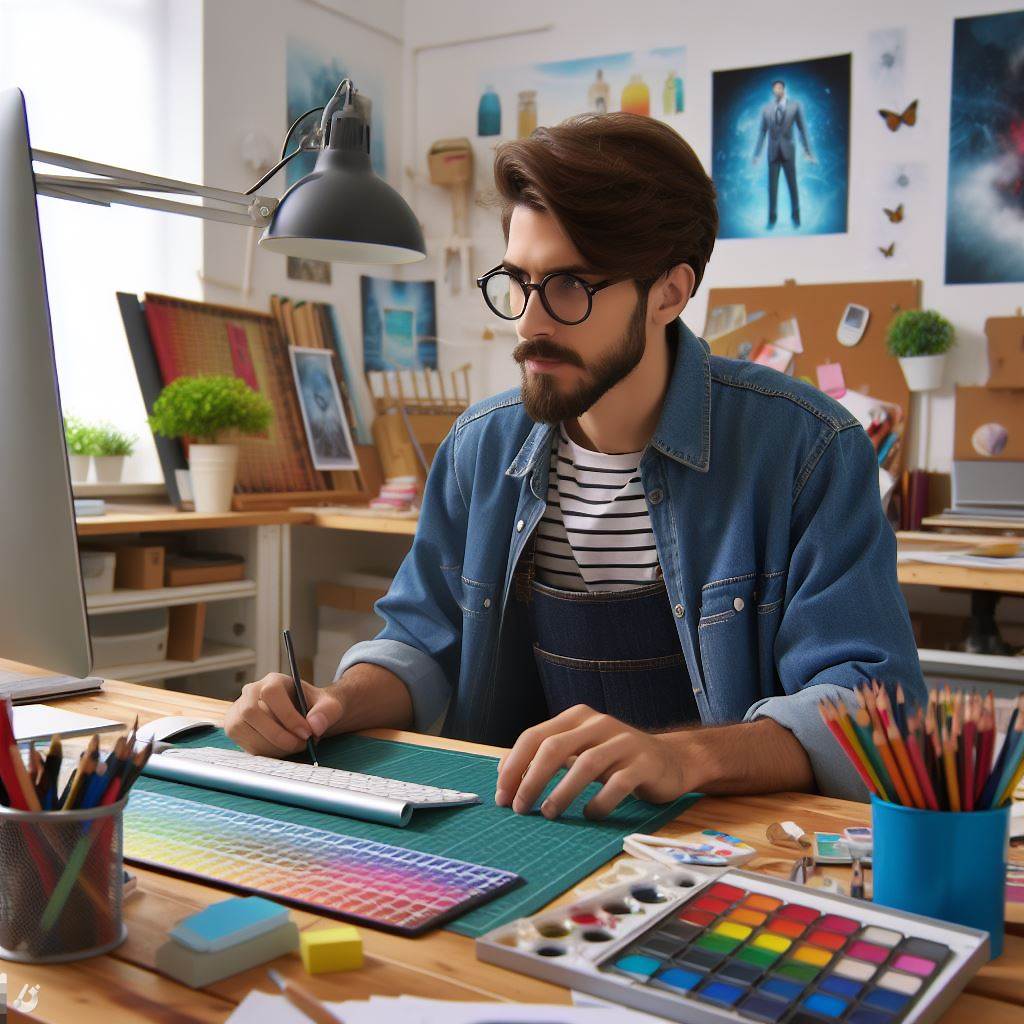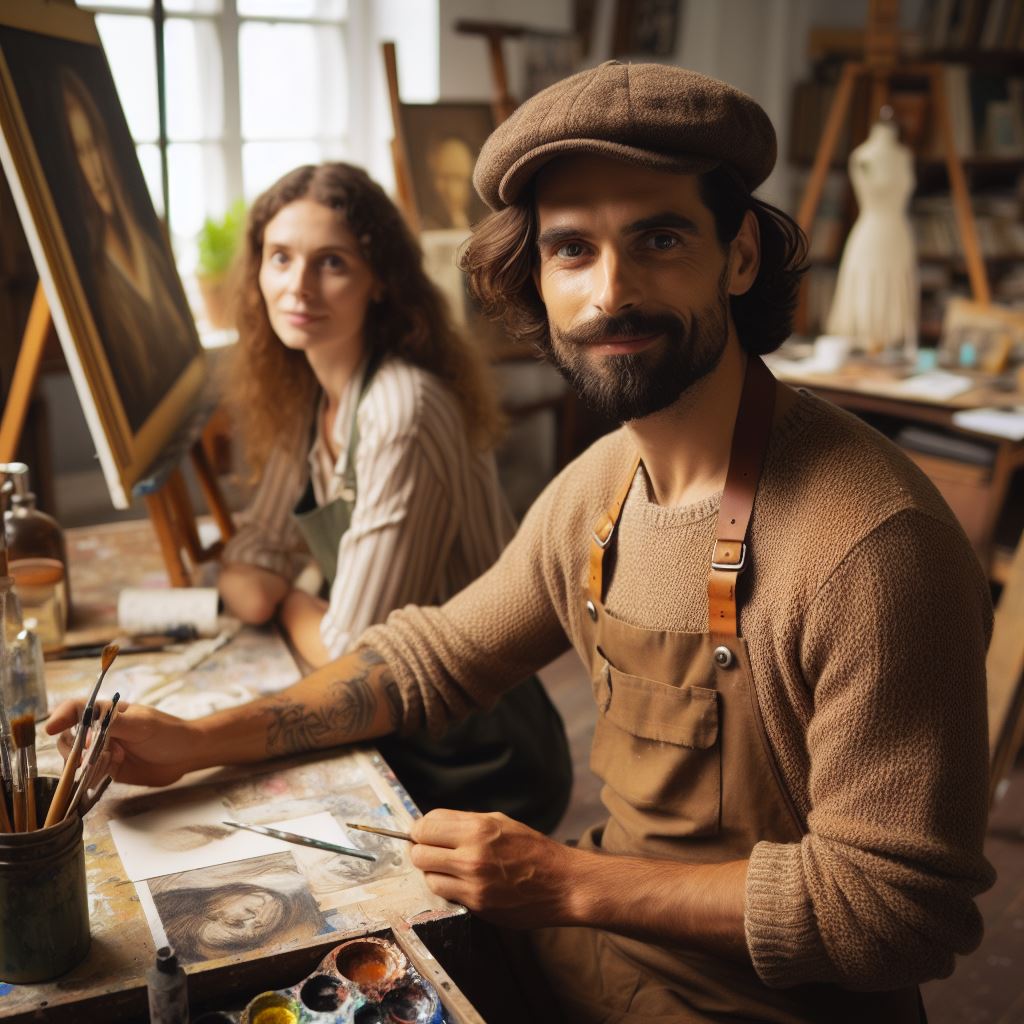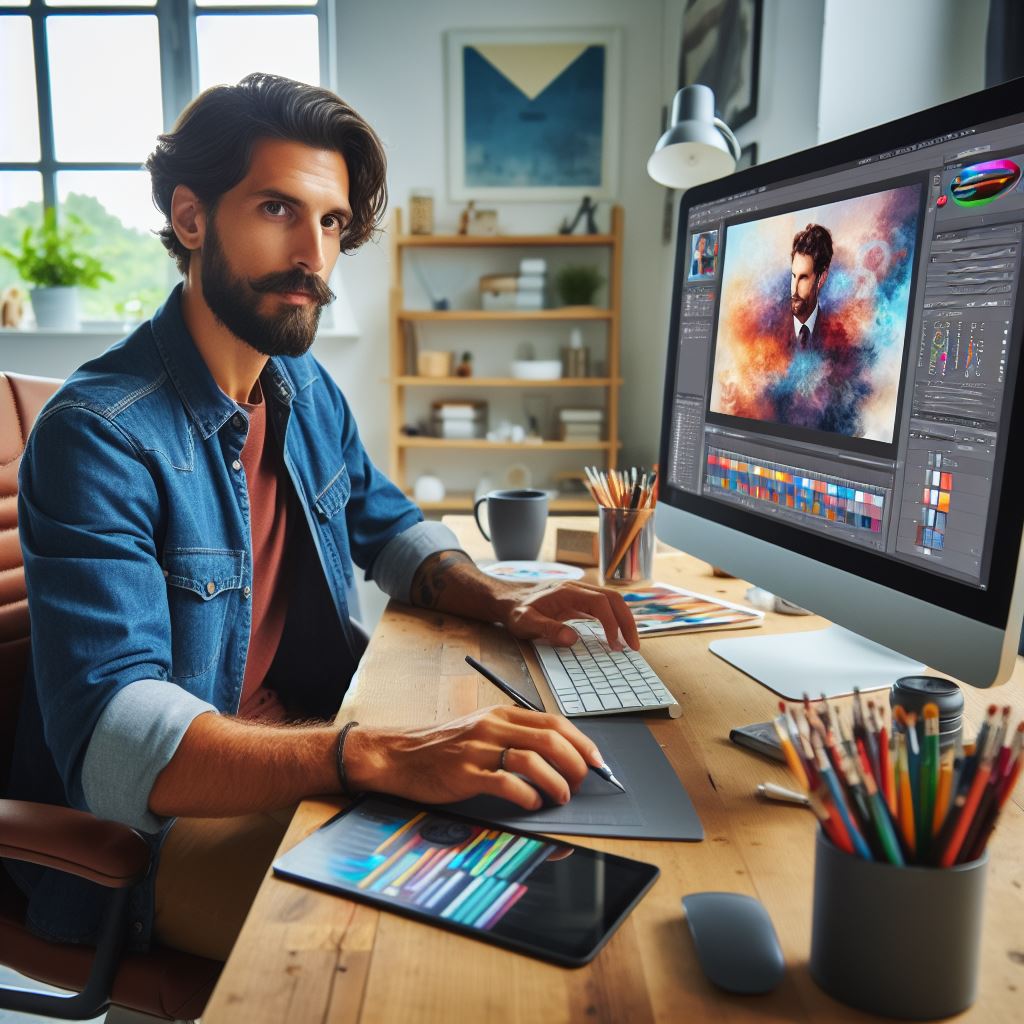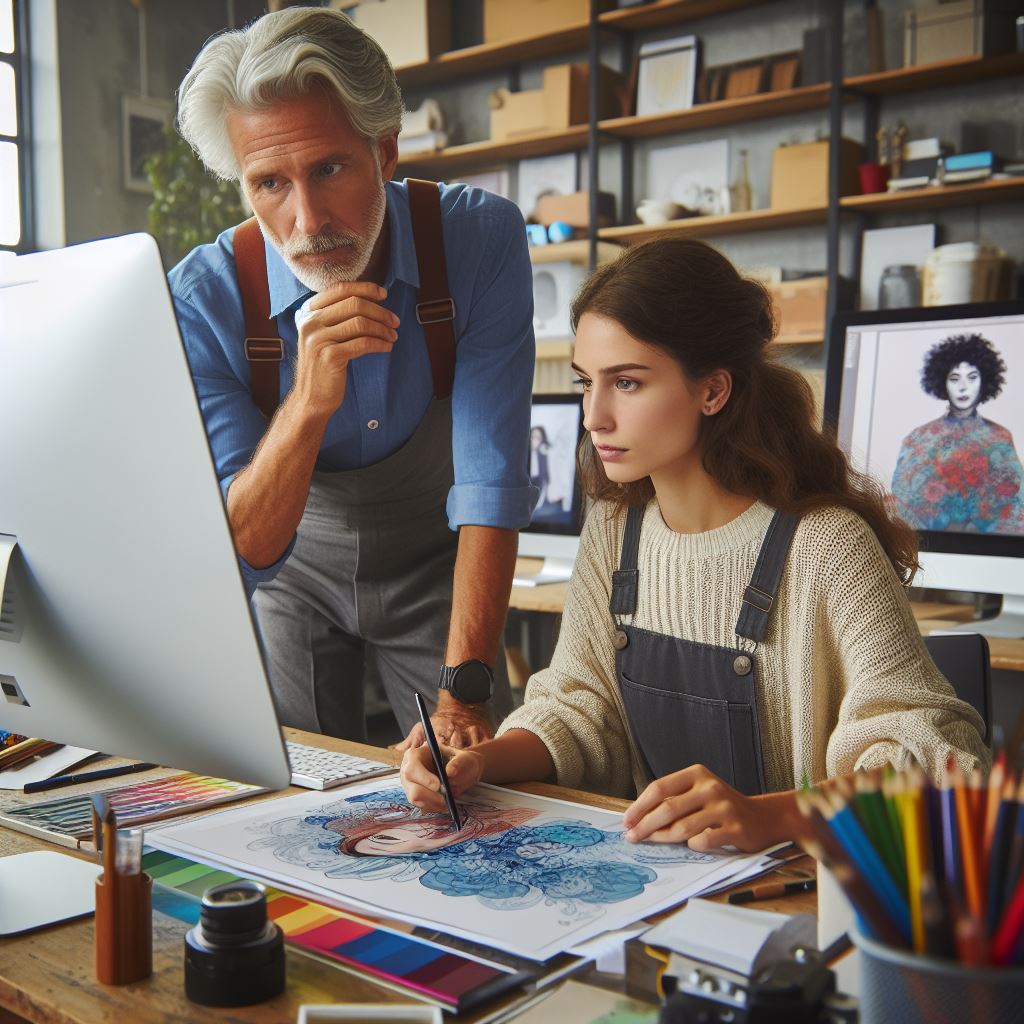Introduction
In this section, we will explore the rise of digital art in the UK scene, discussing how it has transformed the way artists create and showcase their work.
A brief explanation of digital art is necessary to understand its significance. Digital art refers to any artistic work or practice that utilizes digital technology as a medium.
Over the years, digital art has gained immense popularity in the UK. This can be attributed to several factors, including advancements in technology and the accessibility of digital tools.
The rise of digital art in the UK scene has had a profound impact on artists. It has revolutionized the creative process, allowing artists to experiment and explore new techniques and styles.
Furthermore, digital art has enabled artists to showcase their work to a wider audience. The internet and social media platforms have provided an inclusive space for artists to share and promote their creations.
Basically, the rise of digital art in the UK scene has brought about significant changes in the art world.
It has opened up new possibilities for artists, allowing them to push the boundaries of creativity and reach a larger audience.
The Evolution of Digital Art
Historical overview of digital art
- In the early days, digital art emerged as computer-generated art, pushing the boundaries of creativity.
- The introduction of software and tools specifically designed for digital creation revolutionized the art scene.
- The impact of technological advancements, such as improved processing power and graphics capabilities, greatly influenced the development of digital art.
Digital art in the UK has transformed, propelled by technology, from early computer-generated experimentation to sophisticated, accessible creations.
Specialized software expanded artistic horizons, enabling 3D modeling and virtual reality.
Technological progress, including enhanced processing power and digital tablets, elevated detail and realism.
The democratization of digital art, driven by affordable technology, fosters a diverse UK art community.
Collaboration flourishes, intertwining artists with programmers, animators, and technologists, producing interactive installations and multimedia presentations.
Digital art challenges traditional notions of ownership with NFTs, revolutionizing revenue streams and disrupting the art market.
In summary, the UK’s digital art evolution, from experimentation to disruptive technology, signifies a transformative journey, promising continued innovation.
Digital Art Movements in the UK
Overview of major digital art movements in the UK
- Early pioneers in the field: In the early days of digital art in the UK, there were several pioneers who laid the groundwork for its rise.
- Influential artists and their contributions: Throughout the years, numerous influential artists in the UK have made significant contributions to digital art.
- Collaboration between traditional and digital artists: One notable aspect of the UK digital art scene is the collaboration between traditional and digital artists.
1. Early pioneers in the field
The UK has a rich history of digital art, with early pioneers playing a crucial role in its development.
One such pioneer is Peter Zinovieff, who in the 1960s co-founded the Electronic Music Studios (EMS).
EMS created groundbreaking digital synthesizers, providing artists with new tools for sonic experimentation.
Another pioneer is Frieder Nake, a German-born artist who moved to the UK and became an influential figure in computer-generated art.
Nake’s work explored the visual possibilities of algorithms and computer programming.
His experiments laid the foundation for the use of mathematical principles in digital art.
2. Influential artists and their contributions
Over the years, numerous artists in the UK have made significant contributions to the digital art scene.
One such artist is Damien Hirst, known for his provocative and controversial works.
Personalized UK Career Consulting
Receive tailored career guidance designed just for you. Get actionable steps and expert support to boost your career in 1-3 days. Take control of your career now.
Get StartedHirst has embraced digital technology in his art, using it to create immersive experiences for viewers.
His use of innovative materials and digital manipulation has pushed the boundaries of traditional art forms.
Another influential artist is Rachel Ara, who combines traditional craftsmanship with digital media.
Ara’s work often explores themes of gender, identity, and technology.
Her unique approach has attracted attention and recognition within the art world.
3. Collaboration between traditional and digital artists
One of the unique characteristics of the UK digital art scene is the collaboration between traditional and digital artists.
Many artists are exploring the possibilities of merging traditional artistic practices with digital technologies.
For example, painters are incorporating digital elements into their artworks, blurring the boundaries between the physical and the virtual.
Sculptors are using digital design and fabrication techniques to bring their creations to life.
These collaborations have led to the emergence of new hybrid art forms that challenge traditional notions of art.
The exchange of ideas and techniques between traditional and digital artists has enriched the UK art scene.
It has fostered innovation, experimentation, and the creation of unique artworks that reflect the digital age.
In a nutshell, the UK digital art scene has been shaped by the contributions of early pioneers, influential artists, and the collaboration between traditional and digital artists.
These movements have pushed the boundaries of art and opened up new possibilities for creative expression.
Your Dream Job Starts with a Perfect CV
Get a tailored CV and cover letter that captures your unique strengths and stands out in your industry. Let us help you make an unforgettable first impression.
Get StartedAs technology continues to advance, the rise of digital art in the UK shows no signs of slowing down.
The future holds exciting prospects for artists who can leverage the power of digital tools to create groundbreaking works of art.
Read: Day in the Life of a UK Session Musician
Advantages of Digital Art
Versatility and ease of experimentation
- Ability to edit and modify artwork easily.
- Wide range of digital tools to facilitate creativity.
One of the major advantages of digital art is its versatility and the ease with which artists can experiment with their ideas.
Unlike traditional art forms, digital artwork can be easily edited and modified.
This provides artists with the freedom to explore different concepts and make changes without the fear of ruining their work.
The ability to revise and refine their art allows them to push their creativity to new boundaries.
Moreover, the availability of a wide range of digital tools further enhances the creative process.
Artists can choose from various software programs, digital brushes, and filters to bring their visions to life.
These tools offer a level of precision and control that is difficult to achieve in traditional art forms.
The ability to manipulate colors, textures, and perspectives using digital tools opens up a world of possibilities for artists.
Accessibility and democratization of art
- Online platforms allowing artists to showcase their work worldwide.
- Breaking down barriers of traditional art institutions.
Digital art has played a significant role in democratizing the art world by making it more accessible to a wider audience.
Online platforms have provided artists with the opportunity to showcase and sell their work to a global audience.
This has eliminated the geographical limitations that were once a challenge for artists, allowing them to reach potential buyers and collectors from all corners of the world.
Moreover, digital art has broken down the barriers imposed by traditional art institutions.
In the past, artists had to rely on galleries and museums to exhibit their work, which often involved a rigorous selection process.
However, with digital platforms, artists can bypass these gatekeepers and directly share their creations with the world.
This has allowed emerging artists to gain recognition and establish their own following, irrespective of their background or connections in the art world.
In short, the rise of digital art in the UK scene has brought numerous advantages.
The versatility and ease of experimentation offered by digital tools have pushed the boundaries of artistic expression.
Additionally, the accessibility provided by online platforms has democratized the art world, allowing artists to showcase their work globally and breaking down the barriers of traditional art institutions.
These advantages have contributed to the growing popularity and acceptance of digital art in the UK.
Read: Earning as a Musician in the UK Today
Challenges and Criticisms
Authenticity and reproducibility concerns
One of the major concerns surrounding digital art is the issue of authenticity and reproducibility.
With the ability to create perfect copies and reproduce artworks with just a few clicks, questions arise about the originality and value of digital artworks.
Addressing issues of originality and limited editions
To counter these concerns, artists often employ limited edition releases for their digital artworks.
By limiting the number of copies available, artists create a sense of scarcity and exclusivity, similar to traditional art forms.
This approach helps preserve the value of digital artworks and addresses the question of originality in the digital realm.
The role of digital signature and certification
Furthermore, the use of digital signatures and certifications adds an additional layer of authenticity to digital artworks.
Digital signatures, like their physical counterparts, provide a way to verify the authorship and integrity of a digital artwork.
Certifications from reputable organizations can also act as stamps of approval, assuring collectors and viewers of the artwork’s authenticity.
Digital divide and accessibility barriers
The rise of electronic art. in the UK scene has brought forth several challenges and criticisms that need to be addressed in order to fully embrace and appreciate this evolving art form.
While electronic art has gained popularity, it is important to recognize the existing digital divide and accessibility barriers that prevent some individuals and communities from fully participating and engaging with this art form.
Limited access to technology and software
Not everyone has access to the necessary technology and software required to create or experience digital art.
High-end equipment and software can be costly, making it difficult for artists and enthusiasts from lower socio-economic backgrounds to participate in the electronic art. scene.
Bridging this gap is essential to ensure inclusivity in the UK electronic art. scene.
The exclusion of marginalized communities from the digital art scene
Marginalized communities are often underrepresented in the electronic art. scene.
Lack of access, opportunities, and representation further perpetuate inequalities within the art world.
Efforts must be made to create an inclusive environment that welcomes and celebrates diverse perspectives and voices in the digital art community.
In fact, while the rise of digital art in the UK scene has brought about exciting opportunities, it is crucial to acknowledge and address the challenges and criticisms it faces.
By tackling concerns of authenticity and reproducibility through limited editions and digital signatures.
And by addressing the digital divide and inclusivity barriers, the UK digital art scene can continue to flourish and evolve into a thriving and inclusive artistic community.
Read: Balancing Gigs & Life: UK Musicians’ Tips
Optimize Your LinkedIn for Success
Boost your LinkedIn profile with a professional bio, keyword-rich headline, and strategic recommendations that attract recruiters. Stand out from the crowd and get noticed.
Optimize Now
Impact on the UK Art Scene
The rise of electronic art. in the UK has had a profound impact on the country’s art scene.
Not only has it brought about changes in the way art is exhibited and consumed, but it has also influenced educational institutions and their curriculum.
Shifting dynamics in art exhibitions and galleries
- Inclusion of digital galleries and online platforms revolutionize the way art is displayed and accessed.
- Hybrid exhibitions that combine digital and traditional artwork blur the boundaries of artistic mediums.
1. Inclusion of digital galleries and online platforms
With the advent of electronic art., traditional brick-and-mortar galleries are no longer the sole avenues for exhibition.
Digital galleries and online platforms have emerged, offering artists a virtual space to showcase their works to a global audience.
This shift has democratized art by breaking down geographical barriers and increasing accessibility.
2. Hybrid exhibitions combining digital and traditional artwork
The boundary between digital and traditional artwork has become increasingly blurry in recent years.
Many exhibitions now embrace a hybrid approach, with the combination of digital and physical pieces creating immersive and interactive experiences for viewers.
This shift challenges traditional notions of art and expands the possibilities of artistic expression.
Influence on educational institutions and curriculum
- Integration of electronic art. courses and programs cater to the growing demand for digital expertise.
- Opportunities for interdisciplinary collaborations emerge, fostering innovation and creativity among artists and students.
1. Integration of digital art courses and programs
Recognizing the growing importance of digital illustration, educational institutions in the UK have started integrating digital illustration courses and programs into their curriculum.
These courses equip students with the skills and knowledge needed to navigate the electronic art. landscape.
They cover a wide range of topics, including digital painting, 3D modeling, animation, and virtual reality.
2. Opportunities for interdisciplinary collaborations
The rise of digital illustration has created opportunities for interdisciplinary collaborations between artists, designers, technologists, and researchers.
By working together, they can explore new ways of creating and experiencing art.
These collaborations foster innovation and creativity, pushing the boundaries of artistic expression and pushing the UK art scene forward.
Overall, the rise of digital illustration in the UK has had a transformative impact on the country’s art scene.
It has changed the way art is exhibited and consumed, as well as influenced educational institutions and their curriculum.
By embracing digital technology, the UK art scene has become more inclusive, accessible, and innovative.
The integration of digital illustration courses and interdisciplinary collaborations ensures that the future of the UK art scene remains dynamic and vibrant.
Read: From Garage to Gigs: UK Bands’ Journeys
Future of Digital Art in the UK
Predicted trends and developments
Advancements in virtual reality and augmented reality.
Virtual and augmented reality technologies are expected to play a significant role in the future of digital illustration.
Artists will have the ability to create immersive and interactive art experiences that can be viewed and interacted with using VR and AR devices.
Exploration of interactive and immersive digital art experiences
Artists will continue to push the boundaries of digital illustration by creating interactive and immersive experiences.
This could include installations that respond to the viewer’s movements or allow them to actively participate in the artwork.
Potential challenges and considerations
Copyright and intellectual property protection
As electronic art. becomes more prominent, ensuring copyright and intellectual property protection will become crucial. Artists will need to find ways to protect their work from unauthorized copying or distribution.
Ethical implications of AI and machine learning in digital art creation
The integration of AI and machine learning in the creation of digital illustration gives rise to ethical quandaries, particularly concerning issues of authorship and originality.
As algorithms play a substantial role in the artistic process, questions about accountability and transparency become increasingly pertinent.
Looking ahead, the trajectory of electronic art. in the UK suggests several anticipated trends and developments.
Advancements in virtual reality (VR) and augmented reality (AR) technologies are poised to provide artists with novel opportunities to craft immersive and interactive art experiences.
This progression is set to redefine the boundaries between traditional and digital artistic expressions.
An emerging trend within the digital illustration landscape is the exploration of interactive and immersive experiences.
Artists are expected to delve into the creation of installations and artworks that respond dynamically to the viewer’s presence, fostering active participation.
This interactive dimension not only captivates audiences but also challenges the conventional notion of passive art consumption.
Despite the exciting prospects, the evolution of the digital illustration scene brings forth potential challenges that demand thoughtful consideration.
Paramount among these is the heightened significance of copyright and intellectual property protection.
With the effortless reproduction and distribution of digital files, artists must formulate effective strategies to safeguard their creations from unauthorized usage.
Conclusion
Throughout this section, we explored the rise of digital illustration in the UK scene and highlighted its transformative impact.
We discussed how digital illustration has gained recognition and acceptance in the UK art scene, challenging traditional notions of art creation and consumption.
The use of technology and digital tools has allowed artists to explore new mediums and push the boundaries of creativity.
The accessibility and global reach of digital illustration have also enabled artists to connect with a wider audience and showcase their work in unique ways.
The transformative impact of digital art on the UK art scene cannot be underestimated
The impact of electronic art. on the UK art scene is undeniable. It has democratized the art world, giving artists of all backgrounds and skill levels the opportunity to create and exhibit their work.
The digital realm has provided a platform for marginalized voices and underrepresented artists to find their place in the art world.
This inclusivity and diversity have enriched the UK art scene, bringing fresh perspectives and challenging traditional norms.
Looking ahead, the future possibilities and potential of digital art in the UK are endless
Looking ahead, the future possibilities and potential of digital illustration in the UK are exciting. Technology continues to evolve, offering new tools and possibilities for artists to experiment and create.
The blending of digital and physical art forms opens up endless opportunities for innovative and immersive experiences.
Digital art has the potential to redefine how we perceive and interact with art, creating dynamic and interactive installations that transcend the boundaries of traditional art forms.
In the end, the rise of digital illustration in the UK scene has revolutionized the art world.
Its transformative impact has redefined traditional notions of art, democratized the creative process, and brought diversity and inclusivity to the forefront.
The future holds limitless possibilities and potential for digital illustration in the UK, and we can only anticipate further advancements and boundary-pushing creations.
[E-Book for Sale]
500 Cutting-Edge Tech Startup Ideas for 2024 & 2025: Innovate, Create, Dominate
$19.99 • 500 Tech Startup Ideas • 62 pages
You will get inspired with 500 innovative tech startup ideas for 2024 and 2025, complete with concise descriptions to help you kickstart your entrepreneurial journey in AI, Blockchain, IoT, Fintech, and AR/VR.




